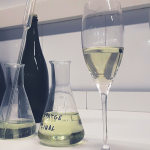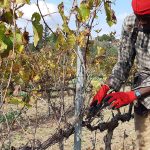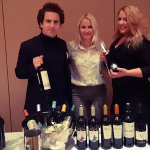


The oenologist’s work, in the process of elaborating a cava, is an arduous and responsible task. He, throughout the year, assumes completely different functions and must remain alert to each type of process. In the steps prior to mixing varieties, the oenologist’s role is similar to that of an orchestra director, it is he who gives his approval to start the collection of the grape, it is he who chooses the yeasts to be used for the alcoholic fermentation, and it is always he who controls almost obsessively and restlessly that the temperature of the tanks remains stable and, during all this time, he does not close his eyes at night, and if he does, it is only to dream about his wines and about the next steps to do to get a product of excellence. However, at this time of year, our winemaker assumes a much more complex, mystical and magical role. It becomes the true creator, who molds, with everything he has at his disposal, his raw diamonds, the wines, which he will have to polish little by little in the following steps to obtain our cavas of optimum quality. The hand of the winemaker is seen in the blend of the wines, mixing the different components that constitute a finished product. It is very difficult that a base wine obtained in a single harvest and coming from a single vineyard and from a single vine variety can provide the perfect aromatic balance and the level of sugar and acidity necessary to produce an excellent cava. This is why we usually mix different varieties of still wines, in our case, always from the same vintage, producing Vintage Cavas every year. This procedure is carried out directly at the end of the first fermentation and is considered the real key in the art of cava production. What we are looking for in our winery is to contribute what is missing to a component with one that has it, something like leveling the lame leg of the table, to achieve complexity and originality in the finished product. Due to the long aging on the lees of our cavas, our winemaker has a difficult task, since it is difficult to predict the result of the mixture. There is no chemical formula in force to know how to get it, this is intrinsic to the considerable experience of our technicians, their knowledge, their philosophy of product style and their magic touch;).
The initial blend of still wines in the denomination of origin Cava involves the use of 9 varieties of grapes such as Macabeo, Xarello, Parellada, Chardonnay, Malvasia, Trepat, Garnacha, Monastrell and Pinot Noir, to give life to a wine that is subjected to a second fermentation, the key passage in which the perlage (bubbles) is formed in the cava.
To make a blend we need (and certainly we have) a team of tasters of great experience, sensitivity and finesse, who as composers must be able to perceive the particularities of each individual element to put it in value in its entirety. They have to be visionary, creative and be able to imagine what they want to achieve, thinking about how to improve and how to make the product exponentially more attractive, staying anchored to the style of our winery.
The secret is to choose expressive base wines from the point of view of softness, warmth on the palate and acidity. According to our experts will be chosen which way to undertake, opting always for obtaining a fine, sophisticated and well-integrated bubble and reaching very elegant finishes with great complexity in the aftertaste. The variations are endless and the tasting of the blend is a discipline that requires rigor, knowledge, ability to perceive the future and must be nourished by a great passion.
Professional tasters or simply CAVA ENTHUSIAST, we are intrepid to know how we will evolve our 2018 vintage.

This week we have started with the pruning of the vines, a very important process that will determine the quality of the grape, and as a consequence the quality of the wine of the next harvest. That is why we can affirm that pruning is one of the most important tasks carried out in the vineyards throughout the year. But … What does it really mean to prune?
It deals with a meticulous job that consists of cutting the ramifications of the strain to prevent it from growing in an uncontrolled way. The period to do it goes from mid-November to the end of February (depending on the area and the vine-grower). This is the best period because it is when the vine goes into winter recess, that is, it minimizes its activity.
The objective of pruning is to leave an optimal number of buds to obtain a good quality of grapes in the future harvest.
The plant of the vine is not as we are used to seeing it in the vineyards. It is really a long-branched shrub that grows by clinging to other trees and distributes its fruits in a completely random way. Therefore, pruning is essential to control the plant, but also to shape it we regulate the production and ensure a good harvest.
In short, pruning is one of the most important operations for the subsequent obtaining of good grapes, and a good balance of sugars and acidity in ripening and will define many aspects of the next harvest.

The trip with our Wine Discovery distributor is over, like all beautiful things. We can only live from the memory of the experiences lived with this magnificent team of professionals, energetic and positive people, and deep connoisseurs of Wine market.
The question that came to us as soon as we landed in Moscow was: How can we survive such beauty?
In Moscow, there are three ways to survive the winter: firstly, to put on the ušanka, the typical Russian hat, secondly to enjoy vodka and thirdly to get lost in the literature, art and history of this enigmatic country.
We have chosen this last option. We did not stop at the memories of the novels we read at school, but we faced the cold and spent our short moments of free time in the places of poets and writers who left a lasting and authentic footprint in the history of the entire world.
People must savour Moscow and visit it with all tranquillity, starting with the most famous places to look for the most remote corners that hide unique beauties.
Everything started from the famous Red Square, which houses cathedrals, museums and complexes rich in history and culture up to the Cathedral of San Basilio, known throughout the world for its colours and its multiple cover in the form of onions. The acrid air reddened our cheeks and gave us the vitality of walking to Pushkin State Museum of Fine Arts and Lenin’s mausoleum, in which the body of the famous politician is in a glass coffin. The last stop was Patriarshiye Prudy, a wonderful park famous for the meeting between the master and Margarita, and after the walk through this artificial lake, we reached the famous bar Margarita, to taste the delicious aromatic chai (thé) that warms the body. In this artistic place, we lost ourselves in the conversations of the eccentric visitors, in the wise speeches that warm the heart instead of the body.
Right in this city of history and modernity we witnessed the event “Salon of Spanish wines” in the famous Telegraph, accompanied by the Training Manager Elena Gurikova, a charming woman, always concerned about us, attentive to our well-being, exquisite, very pragmatic and fast in the impeccable organization of our stand.
Wineries such as Iniesta, Avelino Vegas, Sommos, Nabal, Protos, Marqués de Cacéres, Viña Vilano, Codorniu, Gonzalez Byass, Grupo La Rioja Alta, Pago Heredad de Ureña, Viña Ijalba, Vinoterra, Raventos, and Juve and camps attended the event.
The influx of people was extraordinary, with good feedback from the tasters who appreciated our Cava Mont Marçal rosé with its delicacy, due to the freshness of the rose petals, those petals bathed in the morning dew, our sophisticated Brut Nature Extremarium, elegant and vigorous, and our Mont Marçal cuvé noir, where the carbon is in a fantastic balance and adapted to all occasions.
The Chief Natalya Bukata, a determined, professional, knowledgeable and quality-loving woman gave us a general and satisfactory vision of Wine Discovery. It was extraordinary how we fit into the way we work and achieve high goals. For its part, she is very satisfied in communication and organization and, for our part, we are delighted of the rigidity and perfection in the way of managing all processes: together we are an indestructible machine, a machine where all the gears work perfectly and, with the necessary care, it will continue to work.
The second stop of the Spanish Wine Hall was in St. Petersburg. The history of this city is full of events, and even today the city seems to oscillate constantly between a very recent past, to which all Russians are inevitably anchored, and advanced modernity. This is the story of a city born in 1703, about the “decree” of Tsar Peter I, also called Peter the Great, who wanted to make the new capital of the Russian Empire from the swampy banks of the Neva River.
“This is not a place for man because men are not fishes,” Prince Menshikov told Peter I.
Shortly, after becoming capital (just in 1712), St. Petersburg literally had to invent a past, which obviously had no, and did it thanks to the intellectuals who populated the city over the centuries to come. Authors such as Alexander Pushkin started to reinvent the city, to give it a soul, to capture its atmosphere until it became a mythical city, at the same time idolized and suffering, source of love and cause of pain.
The event took place in a modern centric building, in the company of a sensational team.
The manager Irina Loseva, faithful companion that we describe with two words: patient and scrupulous. Alert and careful of all the details so that our stand stood out in prestige and increased the value of the products. The General Manager Dmitry Bezdetko, a measured and observant man, the Regional Managers such as Anatoly Kurto, a nice and energetic figure, Evgeniy Druzhinin, the soul of the festival with his joy, good humour and wisdom and his excessive love for our cavas, and Sasha, a dynamic young and active person, knowledgeable and charming that attracted a lot of people due to its interesting technical explanations. Only thanks to the help of this formidable group, we were able to achieve the desired success, finishing our range of products very quickly ….So we deserve a fantastic Russian-style dinner!
The last stop was Ekaterinburg, a mystical and mysterious city. From an abandoned village of miners, it has grown to become the third largest city in Russia. For several decades, it was a closed territory, whereas today it is a strange megalopolis full of mysteries and anecdotes, which seems to live in several dimensions.
The monuments of Ekaterinburg could cause a cultural shock to any tourist.
Among many buildings and sculptures, we remember the monument dedicated to Invisible Man, represented by a series of impressions of different sizes; the monument to curiosities; the keyboard monument and, finally, the one devoted to love, a 7-ton rock made of pink rhodonite and extracted in a local deposit. Without forgetting that Tsar Nicola paid in this city the errors committed by his ministers and by himself.
The event took place in the luxurious Hyatt Regency Hotel, with a high participation and a more technical audience, expert restaurateurs, sommeliers and distributors.
There, Aleksey Rybkin,, the Responsible of the Urals Region, introduced us to restaurants and wine shops where we just entered with our portfolio of products. After an entertaining day, we armed ourselves with energy deciding to visit these places in order to present and enrich with our explanation the range products. We used only two support materials: power point presentations and … a lot of enthusiasm!
The most difficult part now is waiting to go back to work side by side with Wine Discovery … but meanwhile, we will plan something, probably an imminent visit to our Bodega Mont Marçal.
In this way, we do not have to wait so long and we can follow our project together, side by side, soon!
Recent Comments